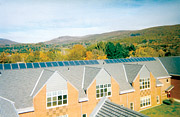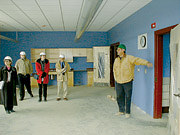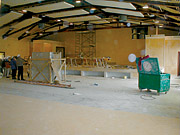

When you think of picturesque New England towns, you could be thinking of Williamstown, MA. With a population of just over 8,000 (including students), Williamstown is known for the scenic beauty of its surrounding mountains, as well as for Williams College, one of the nation's top liberal arts colleges.
It is also home to the newly built, energy-efficient Williamstown Elementary School. The previous school, which was old and outdated, was completely torn down to make way for the new 89,000-sq-ft facility, which opened for business in September 2002. The $14.5 million school serves 530 students from preschool through sixth grade.
What makes this school unique is that the AE firms involved worked closely with the school building committee to design a facility that far exceeds code requirements. This has allowed the school to not only save energy but to also become eligible for a "green school" grant, which included the installation of a photovoltaic array.
The Importance of Air
Williamstown Elementary is a two-story school building, containing the usual assortment of classrooms, office space, kitchen and cafeteria, gymnasium, and auditorium. What wasn't usual about this project was the school's building committee, which did a lot of research into what equipment should be used to provide the healthiest environment for the children."We were looking for durability, efficiency, as well as the overall health of the environment," said Paula Consolini, coordinator of experiential education, Williams College, former chairperson of the Williamstown Elementary School building committee, and member of the school building committee. "We were very focused on research, and we learned that the rate of air exchange had a direct relationship with how sick people were going to get. The studies had shown that a healthier building is a building where the air is exchanged more frequently than the existing state code required."
To that end, ventilation became very important. "The key feature of this mechanical system is the energy recovery units that we used for ventilating the classrooms. That saves a large chunk of the energy," said Dan Lewis, P.E., partner at Kohler and Lewis (Keene, NH).
Two packaged enthalpy-type SEMCO energy recovery units (ERUs) provide a total of 22,000 cfm (11,000 cfm each) of ventilation air for the classroom spaces. A single unit is located in each of the two air-handling rooms. Enthalpy wheel heat exchangers recover approximately 80% of the sensible and latent energy from the leaving exhaust air to preheat and humidify the incoming outside ventilation air. Two McQuay 15-ton 11.6 EER condensing units were added to each ERU to precondition the incoming air.
The system is sized to provide 15 cfm per person ventilation air, as required by current codes (Table 1). The units are conservatively sized to provide quiet operation and low airside static pressure losses through wheels, coils, etc.
The "Metasys" BAS by Johnson Controls provides an economizer precooling sequence, which allows the ERUs to come on early in the morning when it's nice and cool outside. When this occurs, the units bring in straight outside air without recovering heat.
"This not only cools the space down to the normal cooling setpoint but overcools it down to the heating setpoint," said Roy Swain, P.E., partner at Kohler and Lewis. "If it's a nice cool night, and you can come in and the whole building will be down to 70°F, then you are ahead of the curve in terms of the gradual warming up of the air during the day."
AHUs are used to ventilate the gymnasium, auditorium, and administration areas. The units serving the auditorium and gym are equipped with VSDs and CO2 sensors to adjust the quantity of outside ventilation air to correspond with actual occupancy levels. The gymnasium unit is sized to provide a maximum of 9,000 cfm, the auditorium unit is sized to provide 6,000 cfm, and the administration unit is sized to provide 2,800 cfm of total supply air.
"The CO2 sensors cut down the amount of outside air we're bringing in, and it also slows down the fan," said Lewis. "We have a fairly large air-handling unit for the gym. The CO2 sensors can turn the unit off until the levels rise, then it can turn on the unit slowly. That saves a lot of energy."
The administration area is air conditioned and ventilated using a traditional 7-ton split system from McQuay. Three computer rooms are air conditioned through the use of Mitsubishi ductless split systems. The cafeteria is ventilated using four unit ventilators, and air is exhausted through the kitchen.
One part of the facility that may also need air conditioning soon is the auditorium. "The auditorium is on the second floor and makes use of the roof. That space got a little uncomfortable in the warm weather," said Consolini. "We're looking into changing the lighting from incandescent to dimmable fluorescent lights, and we're also looking into what we can do with the air."

Heating Efficiently
Heating is provided by three Burnham cast iron modular combination gas/oil fired boilers, which have a gross output of 1.7 MBtuh each. Two boilers are designed to meet the design heating load, while the third boiler provides spare capacity.Joe Kohler, P.E., partner at Kohler and Lewis, said this arrangement works better than the more conventional design, in which two boilers would be specified with each meeting two-thirds of the design heating load.
"In the spring and fall when there's a smaller load, we are matching the load better," said Kohler. "It doesn't cost a great deal more to do it this way, plus there's another advantage: With the three-boiler approach, if one boiler breaks, the school has a complete backup. If the boiler breaks during mild weather, they don't have to rush to fix it."
Heating is distributed to the building by a direct return hydronic loop. The main and spare primary circulators operate with variable-speed controls to save energy. Kohler likes the variable-speed technology, noting that the drives slow down the pumps, so they don't run at full blast.
"The school saves several thousand dollars a year that way. Not only that, you really cut down on the wear and tear on the pump because it's now turning much slower. In short, the VSD sort of matches the pump output to the load on the building. It works hard in the winter when it's cold out, and it works less hard in the summer and spring," said Kohler.
Mains are sized for low pressure drop, and secondary circulators inject heat into the loop to maintain the temperature in accordance with an outdoor reset schedule. Terminal units consist of baseboard radiation in the classrooms, unit ventilators in the cafeteria, cabinet unit heaters in the corridors, convectors in interior offices and some bathrooms, and unit heaters in utility spaces.
"Each room in this school is on its own zone and has its own thermostat. That's a good thing, because you only heat a room as much it needs to be heated and you don't overheat rooms because they're on some zone that needs heat," noted Kohler. The terminal units are equipped with self-balance valves to maintain the desired flow at all times.
The gas/oil combination boilers were selected in order to receive the best rates from the local utilities. "The owners decided on an interruptible rate plan, which means the utility sells gas at a lower price," said Kohler. "When it gets really cold out, they can shut off gas to the school, but we needed to have a second way of heating, so we used oil as a backup."

Better Than Code
Lewis noted that when they started designing the mechanical systems for the school, the goal was not for the systems to be better than code. "We just wanted to make an energy efficient system, and that's what the owner wanted too. During construction, Paula [Consolini] asked us to run the numbers, so they could get some funding for a photovoltaic array."The photovoltaic array was not part of the original construction plan. Consolini had heard about a program sponsored by the Massachusetts Technology Collaborative, which offered programs to advance renewable technology. "We applied for a grant that they offered for schools, and we got it. The panels were installed in October 2003, and we expect that they will help take a bite out of our electricity costs," said Consolini.
In order to qualify for the grant, the school had to prove that its mechanical systems were at least 20% better than code. To determine if the school would qualify, Lewis completed the Carrier Hourly Analysis Program (HAP) simulations of the Williamstown Elementary School. Two simulations were performed: as it was built; and as if it were built to the Massachusetts Building Code in effect at the time of design (prior to the adoption of the current energy code).
These simulations showed that the school as-built was 31.4% better in terms of annual energy cost (with oil estimated at $1.00/gal and electric at $0.104/kWh) than the code building, 12.3% better in terms of electric kWh savings, 48.9% better in terms of oil consumption, and 33% better in terms of source energy savings. Source energy, in Btuh/yr, was calculated from site energy assuming 28% electric generation and transmission efficiency.
Factoring in the photovoltaic array output of 30,814 kWh/yr (and $3,205/yr electric cost savings) these numbers become: 34.5% annual energy cost savings, 18.8% kWh savings, and 36% better in terms of source energy savings. Source energy was calculated to be 8,667,876 Btuh/yr for the as-built building and 13,508,475 Btuh/yr for the code building.
The as-built building requires 27,984 gallons of oil per year (0.35 gal/sq ft/yr) compared to the code building's 54,726 gallons of oil per year (0.68 gal/sq ft/yr). This savings comes primarily from the improved mechanical systems (energy recovery for all of the building ventilation air except for the gym, auditorium, and cafeteria/kitchen, CO2 controlled ventilation for the gym and auditorium, and the improved boiler plant), and secondarily from the improved thermal envelope (better walls, roof, and windows). The infiltration rate was 0.5 ach for both models.
The actual oil consumption of the school was 21,982 gallons from December 2002 through May 2003. A simple degree-day adjustment yielded an annual oil use of 27,534 gal/yr. Oil cost was assumed to be $1.00/gal for both simulations, while the actual oil cost varied from $0.85/gal (May 2003) to $1.32/gal (February 2003).
Electric energy use was 420,510 kWh/yr (5.2 kWh/sq ft/yr) for the as-built building, and 479,670 kWh/yr (5.9 kWh/sq ft/yr) for the code building. This savings is due to increased mechanical system efficiencies, and lowering the lighting load from 1.5 W/sq ft to an average 1.42 W/sq ft.
In addition, VAV and CO2 ventilation controls for the gym and auditorium lowered electrical use, and more efficient equipment for the computer rooms and administration areas lowered air conditioning electrical use by 39% for these spaces. VSD primary/secondary pumping lowered pumping costs by a significant 74%.
While total mechanical system electrical use was lower by 12.3% for the as-built building, total fan electrical use was slightly higher (by 12%) due to the increased fan power required by the energy recovery units (due to the resistance of the energy recovery wheels). The electrical use for the as-built building was 26% for HVAC, 61% for lighting, and 13% for plug loads.
The actual electrical consumption of the school was 477,440 kWh from July 2002 to June 2003, and the average annual cost of electricity was $0.104/kWh. "This average cost was used as a simplifying assumption in the model because the actual rate schedule was quite complicated and varied seasonally," said Lewis. "This would tend to favor the code building in terms of electrical cost, since the peaking electrical cost charge was not modeled."
Consolini said she has been extremely pleased with the finished school. "We're really happy, and we feel very fortunate that we worked with the team that we did. The architects were very involved in all aspects of the work, and Kohler and Lewis was a phenomenal engineering team. They were always available so we could ask them questions, and they were very willing to teach us. I can't say enough positive about them, I really can't." ES
Table 1:
- Interior temperature setpoints: 72°F heating when occupied, 65° when unoccupied;
- Outdoor ambient design temperatures: -8° winter;
- Occupancy: 30 sq ft per person in classrooms;
- Envelope: 44,943 sq ft gross wall area, 8,778 sq ft glazing area, 58,357 sq ft roof area;
- Opaque walls are concrete block walls with an R-value of 12.6, and windows are equal to Pella Design Series with a U-value of 0.34;
- Roof assembly is wood framed rafters with metal decking, with rigid insulation above with a total R-value of 28; and
- Outside ventilation air: 15 cfm per person.
The above are the assumptions used to calculate the capacities and parameters for the building components.

